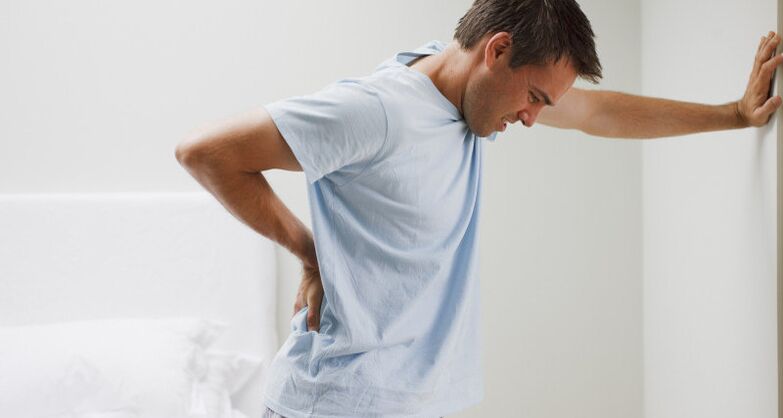Prostate pathology developed due to the inflammatory process in which it is called disease - prostatitis.
The development of pathology
The infectious form of prostatitis occurs more frequently than others. Infections that can penetrate the prostate through the urethra or other organs and glands of the urogenital system.
The high likelihood of organ infection is due to the adjacent positioning of the anus and urethral ducts.
With this possibility, statistics detect inflammation in the male prostate, which is related to the adaptation of the organ to the infected neighbors.
Even the presence of infection in the prostate does not ensure the development of inflammation.
Inflammation of the prostate occurs with the combined action of pathogenic microorganisms and provocative factors.
Causes of prostatitis
Everyone is surprised or understood the inevitability of the disease caused by the aggravation of the triggering factors, and can guess the progression of prostatitis.

The prostate is where the urethral tube passes, so the inflammatory process of the viral organ causes an increase in its structure, leading to invasion of the bladder emptying.
When establishing a diagnosis of different forms of inflammation in the prostate, binary nomenclature is used:
- Chronic non-infection
- Chronic infectious
- Acute contagious
- Acute non-infection
Various prostatitis are caused by complex factors in some cases.
The first statistical factor among young people and men of retirement age spread from sexual partners.
Venus disease, especially in the symptomatic remission stage, can leave infections in hidden states or prostate lesions, even after the infectious agent is eliminated, these lesions are gradually developing.
Infection can supplement infection, systemic overeating, acute nutrition, excessive oily, calorie carbohydrate foods.
This is how non-infectious prostatitis occurs, and the process of non-infectious varieties is enhanced.
Factors that are hypothermia and age-related changes in the prostate.
Signs of prostatitis in men
Based on the similarity of symptoms alone, it is difficult to diagnose infectious or non-infective forms of prostatitis.
If the following signs of prostatitis are detected, a comprehensive diagnosis of the disease is necessary:
- After the urination is over, pain and intensity will be experienced during the emptying of the bladder, and the patient feels a burning sensation in the urethra.
- Body temperature exceeds normal;
- The feeling of emptying the bladder after urination did not cause the patient to leave for a period of time.
- Pain between the perineum, groin and urethra, reflexes on the legs, hips, pelvis and s bones.
- Sleepiness and discomfort.
If at least two are attracted attention throughout the list and symptoms, doubts about prostatitis may arise.
A specific sign of the prostatitis process is the temperature difference measured in different parts of the body.
The pattern of temperature changes is related to the positioning of the focus of inflammation: the closer it is to it, the higher the temperature.
When measuring the temperature in the oral cavity, no deviation from the norm was observed in the axillary - sub-release temperature, and in the rectum, the parameter values exceed the range greater than the extent.
As prostatitis increases, pain symptoms develop with increasing intensity.
Typical occurrence of pain is characterized by the process of emptying the bladder, which during the daytime extends to the entire area of the rectum and perineum.
The intensity of the pain increases with an unbearable amount of smallness.
Pull downers and discomfort may be accompanied by dizziness and headache, small nausea attacks, and lethargy.
If this symptom is detected, there is suspicion of delay in urine, and therefore, general poisoning in the human body can form protein attenuation products.

The deviation in urination is related to the stagnation of the jet, which has a long amount of drip in urine, rather than an imminent jet forming, and calls for emptying the bladder without urine.
Possible complications
Complications that occur after prostatitis occur in the absence of medical intervention during the disease or the treatment plan is improperly prepared.
Medical practice shows the most common distribution after prostatitis:
- lack of erection and ejaculation;
- The inflammation process spreads to nearby urogenital organs;
- Cytological diseases cause sperm to fail to fertilize eggs;
- Reduced sexual desire;
- The state of psychotherapy reduces the quality of life and health of the entire man.
After prostatitis, the penis greatly reduces its ability to harden and fill blood. Possible sexual contact ends quickly compared to the recent complete sex life. Not all sexual contact ends with ejaculation.
If such deviations are detected, a comprehensive diagnostic test is required.
As the inflammatory process spreads to the urethra and bladder, cystitis and urethritis develop.
As the latter develops, sharp pain occurs and the impaired process of urine outflow (its delayed or urinary incontinence) may switch to a chronic level. A person's performance in this state is doubtful.
Erectile dysfunction leaves many psychological and therapeutic problems that require qualified medical correction.
The edema state of the prostate and associated urogenital organs explains the possibility of the cavernous body.
The blood supply of the penis required for upright state becomes problematic.
Psychologically, the third part of men after prostatitis suffers in a serious form.
A person's status can only be normalized in long-term psychological work with a drug treatment background. The failure of sex hinders further desire to continue sex.
Prostatitis can cause invasion of the acid and alkaline components of sperm, which is reflected in the sperm's fertilization ability.
The pathology result is infertility in people of first-level degrees. In this state, it is important to eliminate the causes of infertility in a timely manner, because there is a lack of opportunities to cure second degree infertility using drugs. Suitable treatment may be prescribed by the term or by the urologist. This is why men should not ignore the signs of prostatitis.
diagnosis
The diagnostic test plan is directly dependent on the patient's resolution of complaints and signs from the urologist or hemologist.
The diagnosis of male prostatitis can be performed at home and in medical institutions.
The initial diagnostic phase is data collection for absorption. Doctors perform external examinations on the genitals and listen to patients’ complaints.
Based on the initial data, a plan for further diagnostic studies on the patient was set.
During the collection of anatomy, doctors found the duration of symptoms that appeared, the presence of prostatitis previously shown, the patient's disease list, risk factors for disease development, a list of possible sexually transmitted diseases, the development of the disease signs, the presence of sexual partners and the sexual relationship.
At the current stage of medical development, the question list is posted in the questionnaire and the patient fills out before visiting the doctor’s office. Therefore, the time for the patient and the doctor is preserved.
The first mandatory stage of examination in patients with signs of prostatitis is the prostate study of the rectum.
Doctors determine the extent of the increase in the inflamed organ, its density, consistency of uniformity or the presence of lymph nodes or seals, and the extent of pain during palpation.
Before palpation, perform the intestinal lumen.
In the absence of an inflammatory process in the prostate, there is no pain, there is prostatitis, the intensity of the pain may vary, and their positioning is felt in the inguinal, rectum, vagina, vagina and ac bone. In this case, it is taboo in many processes.
For microscopic examination of prostate secretion, the patient performed the procedure through rectal massage.
This cannot be analyzed because of the desire to urinate before the end of the prostate massage until a drop of a drop from the prostate in the open urethra.
The process ends with the subject glass that microscopes along the urethral hole, and then the smear is painted according to the following parameters and microscopic analysis is performed according to the following parameters:
- The presence and number of leukocytes;
- amount of spike protein;
- Activity and existence of pathogenic microorganisms.

Detection of bacteria in the field of view of the smear indicates the infectious type of prostatitis.
The number of white blood cells in the field of view exceeds 2 or more indicates the inflammatory process in the prostate.
To obtain reliable results from microscopic examinations, it is necessary to perform fence analysis correctly and have the ability to map the drug.
The above tests are mandatory, and the doctor selectively prescribes other tests, depending on the doctor's suspicion of the nature of the inflammation.
Analysis of urethral secrets is performed through a catheter-like tool. On the top of the metal coating, the cotton wool is wrapped.
Urinate for 2-3 hours before passing the analysis. Otherwise, wash the bacteria into the external environment.
The doctor introduced about 4 cm of cotton swabs in the penis hole and performed rotational exercises. The urethra smear was studied to present the presence of DNA and bacterial residues.
The analysis of urine is a method of detecting blood cells: red blood cells and white blood cells, proteins (usually not present or in trace amounts).
When analyzing errors in urethral smears and prostatitis symptoms, urine seeds were prescribed for bacteriological analysis.
The disadvantage of this method is the long-term expectation of pathogenic microbial colonies (up to 1 week).
Seeds are performed by comparison after three parts of urine (the beginning of bladder emptying, the neutralization end) fence.
More pathogenic microorganisms in one of the samples provided the basis for a local focus on hypothesized infection.
The test in the first part of bacterial urine has no reason to confirm inflammation.
The second and third parts of the urine, exceeding the detected number of microorganisms, provide a basis for elucidating the localization of inflammation (in the urethra and bladder, respectively).
By analyzing sperm viscosity and other physicochemical indicators, male gametes' activity and viability and sperm charts are rarely prescribed.
Urology methods are not arranged frequently. If the likelihood of changes and increase, a urinary dynamic test is performed.
Ultrasonography specifies the density of the diseased organs and other parameters obtained after rectal examination of the prostate.
The prostate can be seen in two ways: ultrasound through the abdominal cavity and ultrasound examination.
If adenoma and prostate cancer are suspected, doctors can perform additional cell-scopy on the blood, which is a test that SO is called dogs.
The fence is made from veins and blood tests establish (excluding) the presence of RSA proteins, which appear in malignant tumors.
At home, patients can suspect prostatitis, with the emphasis on the color and turbidity of the urine, the symptoms of the disease.
How to treat at home
Supply of medicines
If there are signs of prostatitis, men should not cultivate themselves, and the medication should only be prescribed by the doctor.
The proposed preparations for curing prostatitis are distinguished in various forms and drug properties. More candles than others prescribe.
The basic principles of choosing a doctor are related to the proximity of the effects of rectal suppositories and prostate components.
The effective effect of the candle is the peace of the patient 30 minutes after the administration of rectal drugs. Candles inactivate pathogenic bacteria and have analgesic effects.
Intramuscular and intravenous injections have the fastest impact on the patient's organs through the blood.
Immediately after urination, regulations aimed at penetrating drugs into the prostate through the urethra holes are prescribed. The maximum dosage is 5 ml.
The table of prostatitis is divided into 3 groups called antibiotics and successfully deals with a variety of pathogenic bacteria of possible species:
- tetracycline
- Fluoroquinolonone
- penicillin
A warm miniature group was conducted at night and the substances were introduced.
The main condition for using enema is that gland strain cannot be consistent with the temperature state. It refers to the folk method of treating prostatitis.

























